Roswell Bob
Solar Enthusiast
I have a LT Spice file if you are interested I will get it to you. Push-pull transformer with voltage doubler secondary - that gets you about 100v out. Two of these supplies on one board with outputs in parallel is then near 200v.I suggested parallel-series transformer confiquration bit earlier: primaries in parallel, secondaries in series. You get perfect current sharing between transformers and mosfets. And you can possibly use 1:1 transformers that simplifies the winding and sourcing parts.
Last edited:



